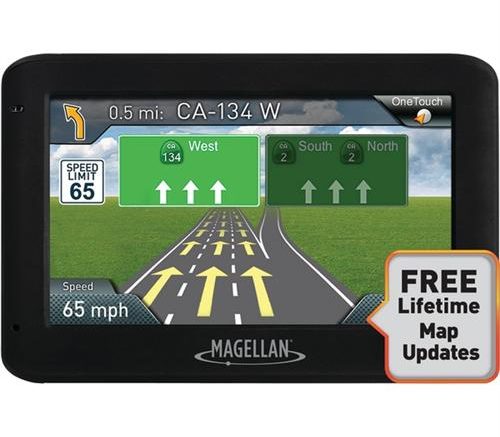Has it really only been 10 years since people started using GPS systems instead of maps? The old days of keeping a road atlas in the car seem decades away. Still, it’s been a swift evolution from chunky and expensive systems with small screens to the sleek, instant on smartphones everyone carries with them.
In the last 10 years we’ve seen GPS systems get built into cars, become a subscription feature on “dumbphones”, seen expensive GPS apps, and eventually we’ve reached the point where all the major smartphones have free turn-by-turn directions with voice navigation. So, it seems like this Magellan Roadmate might be an expensive dinosaur, even though it’s sleek and works well. Why spend even one dollar if your phone can do it for free?
Think about three very real factors, and you may realize that a GPS in the car is still a good idea.
You don’t want to take your eyes off the road, but you don’t want to poke at the windshield. Everyone knows that putting the phone on the seat next to you is dangerous if you spend a lot of time looking at it. It’s critical to keep your eyes on the road. So, there are windshield mounts that you can get for any smartphone. The problem is, you still need to touch the phone more than you would with a GPS. Your phone’s “intelligent assistant” might be able to respond to voice commands but she won’t help you find a song you like on Pandora, Spotify, or in your phone’s memory. Your hands-free system might pick up calls for you but it won’t help you find contact information when you need it. So, you could spend half your time poking at the windshield or you could keep the phone safely within arm’s reach so you can do what you need to do safely.
When you need a GPS, you NEED a GPS.
After the thrill wears off, most people don’t get directions for going around town. They get directions when they are lost, or when they’re trying to avoid traffic. This is when you need something stable, something that works. Your phone’s GPS system downloads maps using cellular data. What if you drive through a dead spot? What if your phone fails you just when you need it? Let’s not even talk about Apple Maps and how it might just take you to the wrong place. You need something reliable for an emergency and a standalone GPS, with its maps stored inside, will work in places that the phone won’t. Any GPS system needs to “see” the satellites it uses for tracking, but a standalone GPS won’t leave you hanging when the mobile internet bogs down or a cell tower is offline.
It might be illegal to touch your phone. Seriously.
Starting January 1, 2017, it’s going to be illegal for a driver to even touch his or her phone. Yes really. The kooky state of California has this new law, and while your state might not be affected today, that doesn’t mean it won’t be affected down the line. In the Golden State, it’s going to be illegal to touch your phone, but it won’t be illegal to operate a standalone GPS. That may not make a lot of sense, but it’s true. So all of a sudden a GPS seems like a good idea since you would otherwise have to pull over even to do something as simple as check the distance to your route.
When you look at it that way, it seems like a pretty good investment.

